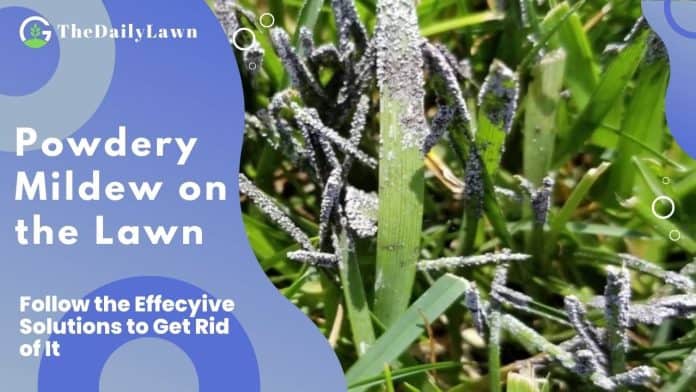Once, someone told me that powdery Mildew on the lawn is the silliest lawn disease. Remember, if anyone told you something like that, it would be good if you simply ignored all his tips from now on. It’s because powdery Mildew cannot be a joke for your lawn. Though it is not deadly, it can be the welcoming agent of other deadly diseases.
If you have maintained a lawn for years, you must be familiar with this irritating lawn disease. However, powdery Mildew is common on the lawn where sunlight is unavailable. Also, there are many other reasons behind it. Though it is very much stubborn, you can get rid of it easily.
Well, today, we will learn everything about this disease. You need to learn everything from the reason for it to its prevention. Also, I will share the 7 most effective tips to get rid of it. So, don’t skip anything and stay connected till the end.
What is Powdery Mildew?
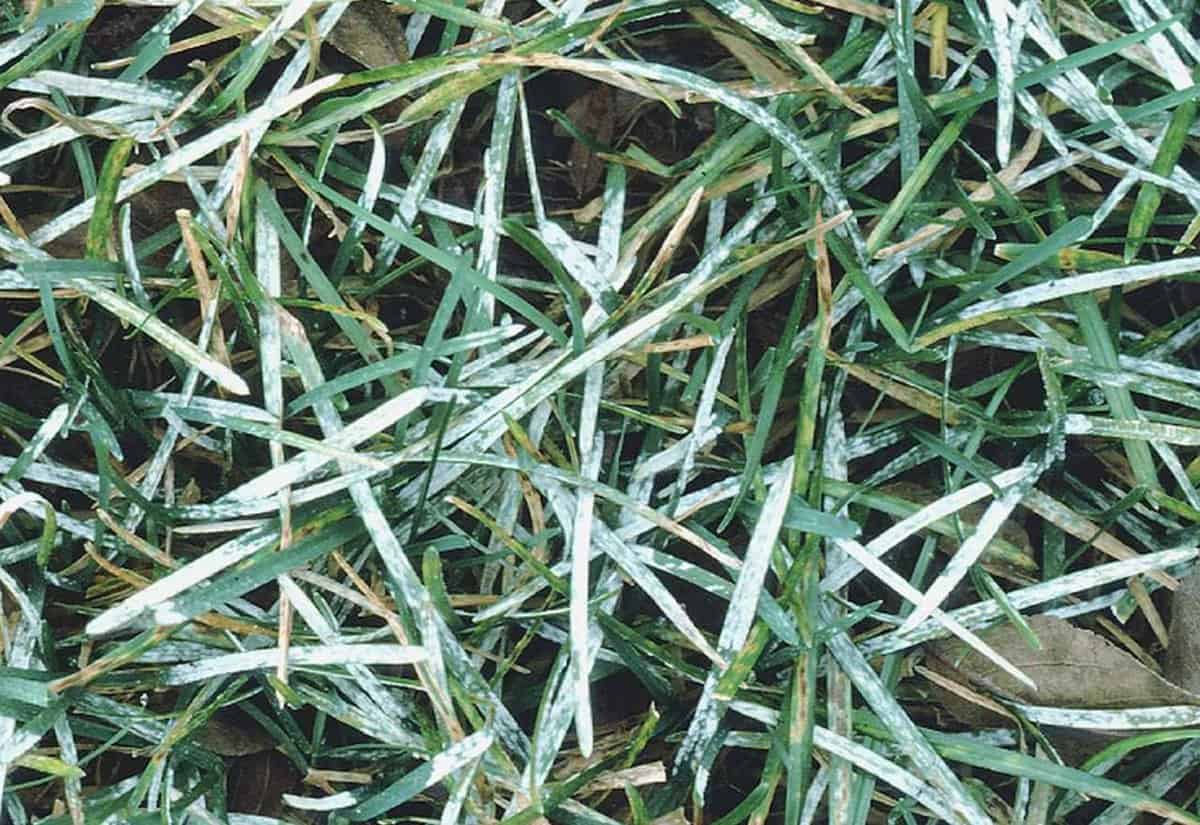 Powdery Mildew is a kind of bacteria that is scientifically known as Erysiphe graminis. It initially invades grass blades and leaves and gradually increases its realms. This plant disease is easy to detect and grows both inside and outside the leaf. You can recognize it by the powdery, white spots on the infected plant stems and leaf surfaces.
Powdery Mildew is a kind of bacteria that is scientifically known as Erysiphe graminis. It initially invades grass blades and leaves and gradually increases its realms. This plant disease is easy to detect and grows both inside and outside the leaf. You can recognize it by the powdery, white spots on the infected plant stems and leaf surfaces.
This irritating lawn disease predominantly affects cool-season grasses, including Fescues, Kentucky Bluegrass and Perennial Ryegrass. During the winter, it nearly looks similar to a layer of frost. As it happens in cool season lawns, the spots are visible between April and September. Besides, the bacteria attack the grass in locations where the temperature is humid and warm.
When and Where Does Powdery Mildew Appear?
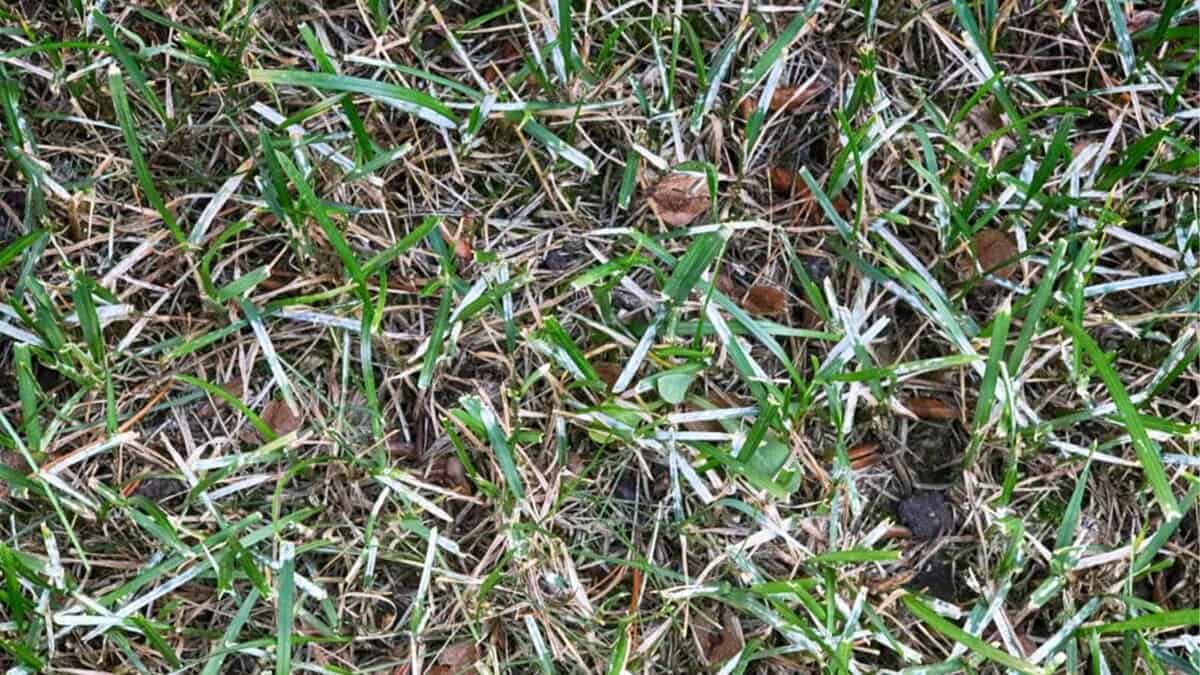 Powdery Mildew usually appears in humid weather conditions. It propagates very fast in warm weather, especially during Spring when the temperature is around 60 degrees Fahrenheit. By Spring, this disease starts to produce spores that are conveyed into the air and adjusted on turfgrass blades.
Powdery Mildew usually appears in humid weather conditions. It propagates very fast in warm weather, especially during Spring when the temperature is around 60 degrees Fahrenheit. By Spring, this disease starts to produce spores that are conveyed into the air and adjusted on turfgrass blades.
However, the ideal environment for spreading this bacteria is cool, drier, and humid climates. The reason is that the grass’s moisture is normal on account of irrigation systems such as sprinkles.
This disease can occur at any place and in any type of lawn grass. Primarily, it spreads the spores in winds to the surrounding plants for infection, and it spreads from directly infected plants and water splashing around from these plants. Furthermore, infected leaf decomposition can also leave white fungus right into the soil beneath the lawn.
The Causes of Powdery Mildew on Your Lawn
 The only surviving method for this fungal disease is to take shelter on the host or grass. Here are some of the common causes that are accountable for Powdery Mildew.
The only surviving method for this fungal disease is to take shelter on the host or grass. Here are some of the common causes that are accountable for Powdery Mildew.
- Dampness and higher humidity level are often responsible for making turfgrass prehensile to powdery Mildew. So, turfgrass needs additional care in areas with higher humidity levels.
- Air temperature is one of the major causes of spreading Powdery Mildew. It can spread and propagate in temperatures from 60 to 70 degrees Fahrenheit.
- Low air circulation may have a bigger impact on developing powdery Mildew. To prevent this, you can aerate your lawn, and pruning back shrubs will also help circulate the air.
- Generally, shady lawns are more susceptible to this disease because turfgrass located in sunny areas does not foster fungal growth.
Besides, this irritating bacterial disease can spread for varieties of reasons. The types of lawn soil and grass can be the cause as well. In this case, we always suggest choosing the grass according to the soil type and weather. Also, you should always choose a more diseases resistant grass for sure.
Easy Treatment for Your Lawn
Indeed, powdery Mildew is not a deadly disease, but it weakens your lawn grass to the point that it will break and die. Here are some methods that might help you treat your lawn grass from Powdery Mildew,
1. Applying Sulfur-rich Fungicide
 Sulfur is one of the common yet effective ways to improve plant health and control Powdery Fungicides. In addition, the amalgamation of Sulfur and fungus intervene together with the cellular respiration of fungi.
Sulfur is one of the common yet effective ways to improve plant health and control Powdery Fungicides. In addition, the amalgamation of Sulfur and fungus intervene together with the cellular respiration of fungi.
You will find this effective in dealing with pests as well. Sulfur fungicide is obtainable as a powder, dust, or liquid, and you can combine it with water to make a safe solution for grass. And remember to follow the user instructions given on the product while applying it. Cover yourself with protective materials as a safeguard against these chemicals.
2. Improve Sun Exposure
Powdery Mildew largely attacks in low-light areas. The absence of sunlight increases the spreading of the spores. Usually, a dense shade allows the humidity to go uphill in the air choked to the ground. Therefore, it will be wise if you trim the plants on your lawn that provide a shady place. And if there are larger trees, you can prune their branches to get the sunlight into the lawn.
3. Apply White Mold and Vinegar Solution
 Generally, Vinegar consists of acidic properties, and it helps to stop the spreading of Powdery Mildew. You might think that Vinegar will burn plants, but diluted apple cider vinegar is entirely safe to use on the lawn.
Generally, Vinegar consists of acidic properties, and it helps to stop the spreading of Powdery Mildew. You might think that Vinegar will burn plants, but diluted apple cider vinegar is entirely safe to use on the lawn.
To prepare this, you must combine Vinegar and water in a tank sprayer, generating a safe acetic acid solution. The measurement should be 2 gallons of water, and you need to mix it with four tablespoons of apple cider vinegar.
No doubt, you can use this as a means of treatment for Mildew without any risk of burning the grass. To avoid any adverse circumstances, you can first test it in a small patch before using a larger area of the lawn.
4. Ensure Sufficient Air and Water Circulation
The general way to improve the air circulation in your lawn is to mow regularly and to keep the glass blades shorter. Appropriate air circulation also limits the time that your lawn will remain damp after sprinkling. Plus, it is adequate to kill moss in unwanted areas on your lawn.
Taller grass actually obstructs blowing the air through individual blades. Morning dew and lack of air allow additional moisture, and it remains on your grass for longer. No wonder it enhances the chances for Mildew to compose.
Not just for the grass area, the air circulation inside the soil is even more essential to cure this irritating disease. Clumping grasses and thickened soil prevent water, oxygen, and nutrients from contacting the root system of the lawn.
To avoid this, you can simply make holes in the soil, which will help increase both water and air circulation in the ground. Proper circulation generates the healthy growth of grass and cures it from Powdery Mildew as well.
5. Apply Neam Oil to the Affected Area
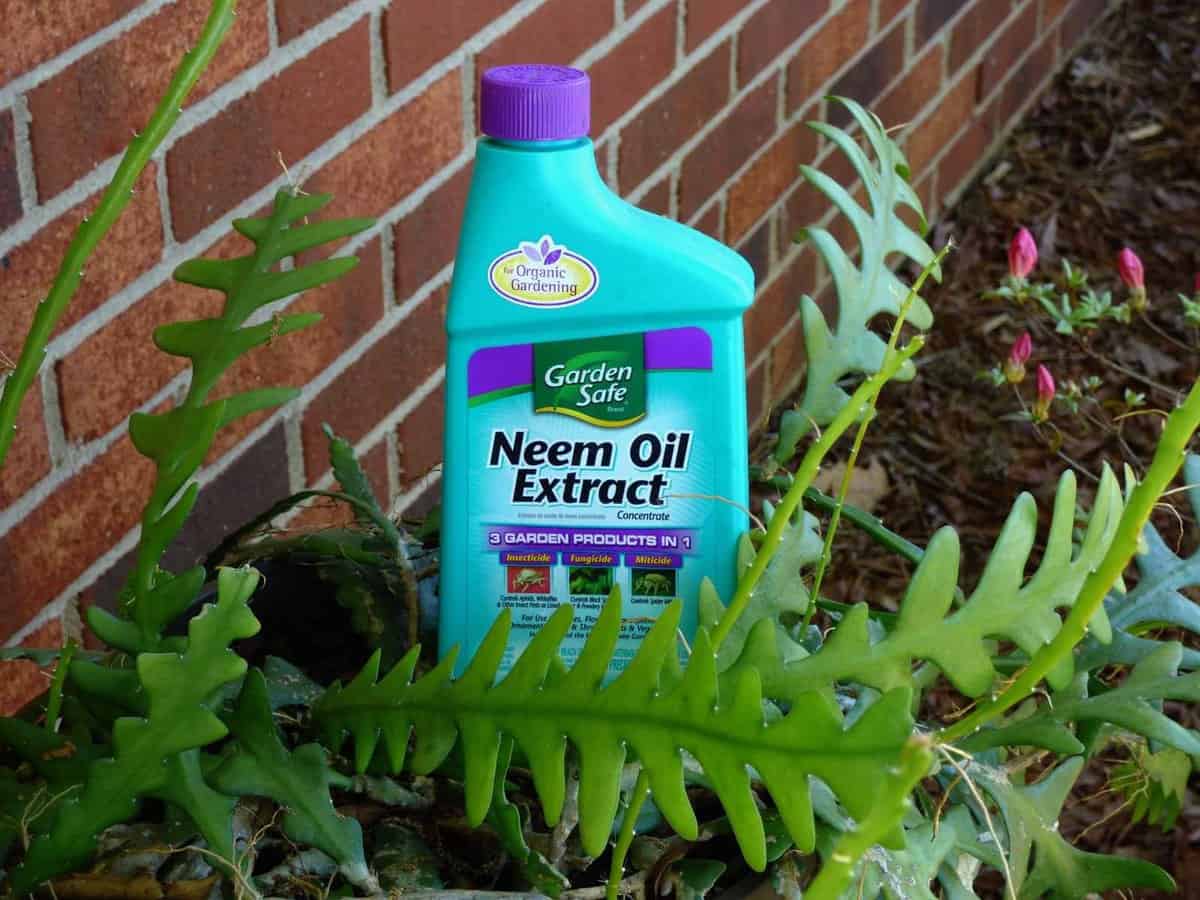 You can choose Neem oil as a natural, non-chemical method to restrain any fungal attack on your lawn grass. It is a cold-pressed product that comes directly from neem trees and has antifungal substances.
You can choose Neem oil as a natural, non-chemical method to restrain any fungal attack on your lawn grass. It is a cold-pressed product that comes directly from neem trees and has antifungal substances.
If you see the chances that Powdery Mildew might occur on your lawn, you can simply spray neem oil to all leaf blades and other parts of grasses. You can even use it with water in a container to spray all over the lawn. The best way to eliminate Mildew and its spores from rising are to apply this solution once a week or every two weeks.
6. Use Diluted Milk to Get Rid of Powdery Mildew
Study shows that diluted milk is an effective solution and works great as a synthetic fungicide. You can make the solution by mixing it with one and a half gallons of water and half gallons of milk.
Then put it in a sprayer medium and apply it to your lawn grass. Furthermore, putting the solution early in the day helps to mix with the sun’s warmth. Here, the protein in milk propagates an antiseptic, obstructing fungus in direct sunlight.
7. Try Potassium Bicarbonate and Water Mixture
 Potassium Bicarbonate is a well-known mineral available to take care of your lawn. It directly kills spores and controls fungus disease spores from the outset. You can easily make this solution at home by mixing two gallons of water, one tablespoon of liquid soap, and two tablespoons of potassium bicarbonate.
Potassium Bicarbonate is a well-known mineral available to take care of your lawn. It directly kills spores and controls fungus disease spores from the outset. You can easily make this solution at home by mixing two gallons of water, one tablespoon of liquid soap, and two tablespoons of potassium bicarbonate.
All you need to do is combine these ingredients in a sprayer medium and spray all the corners of your lawn. Here, The best thing is that you will not need any oil to support its usefulness.
So, these are the easiest ways to get rid of powdery Mildew from the lawn. Besides the fungicides, I have tried to include all-natural solutions. So, it will be helpful for you to apply them instantly. So, as soon as you find any symptoms of powdery Mildew, apply these solutions instantly.
Ways to Prevent This Disease in Your Lawn
Once you get rid of Powdery Mildew on your lawn, you need to take enough preventive measures so that it does not appear again. Here are some of the methods that might help you with the prevention,
1. Exterminating Weeds Regularly
 Weeds generally mess with the lawn because they often stand against the soil’s nutrients and other grasses. It might not have a deadly effect, but it risks the grasses to Mildew.
Weeds generally mess with the lawn because they often stand against the soil’s nutrients and other grasses. It might not have a deadly effect, but it risks the grasses to Mildew.
Grass that thrives alongside the weeds has very short access to enough moisture in soil and sunlight. It happens especially when the weeds grow tall and dehydrate the lawn right after being watered; thus, it helps Mildew to accrete.
2. Boost Your Lawn’s Disease Resistance Capability
Nutrients, including Calcium, are vital for the growth of your lawn grass. Sometimes, maintaining proper soil pH and regular testing might not help, but the collaboration of calcium can enhance the health of your lawn grass.
Calcium makes strong cell walls and helps exploit nutrients available in the soil. Moreover, applying calcium in Spring lowers the chance of any disease, including Powdery Mildew and dollar spots on the lawn.
3. Spraying Baking Soda Frequently
 Baking Soda is one of the most effective solutions to remove Powdery Mildew that grass produces. It protects the lawn grasses from foreign pathogens. To eliminate the powdery Mildew for a longer time, you can mix the baking soda with horticulture oil.
Baking Soda is one of the most effective solutions to remove Powdery Mildew that grass produces. It protects the lawn grasses from foreign pathogens. To eliminate the powdery Mildew for a longer time, you can mix the baking soda with horticulture oil.
You will make this solution by combining two gallons of water, two tablespoons of horticulture oil, and two tablespoons of baking soda. It will generate a safe bicarbonate mixture for your lawn grass and works without proper irrigation or drainage. Likewise, this solution even helps build up strips of magnesium and calcium from the soil and improves plant growth.
4. Follow a Particular Watering Schedule
Watering your grass in the morning increases the humidity and prevents the sun from warming the moisture of the grass. However, lowering the humidity level prevents diseases such as slime mold from thriving on your lawn.
Additionally, the best time to water your lawn is early morning, especially before 10 o’clock. Remember that watering the lawn in the evening makes your lawn more fungous. You may not see Powdery Mildew in the very sight, but if you keep the lawn mistreated, the entire lawn will eventually be coated with white mold, and this will cause extra traffic.
5. Monitor How the Fertilizers Work on Your Lawn
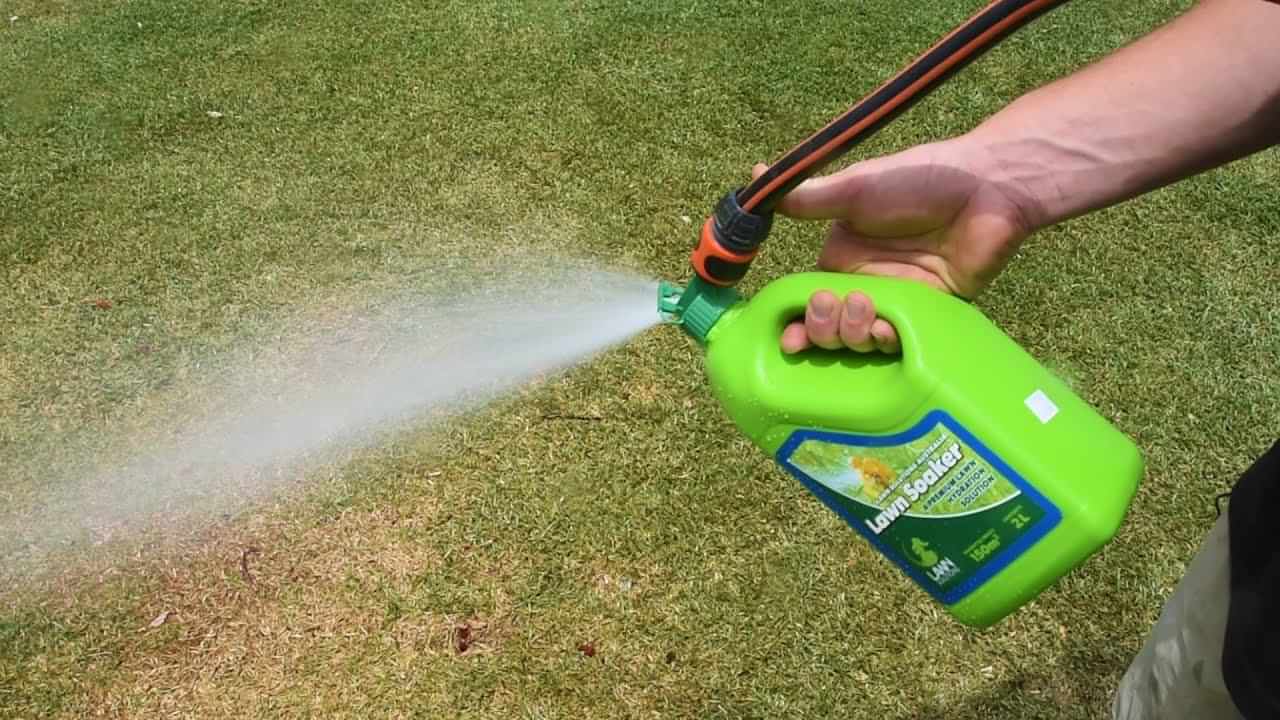
Oftentimes, it happens that fertilizers containing nitrogen help in the development of lawn fungus. So, limiting the application of high nitrogen fertilizers during early Spring is crucial. It will be even better if you can totally avoid them in the cooler season.
No doubt that using too much fertilizer is susceptible to fungus growth. However, unhealthy grass is prone to Powdery Mildew disease. It is wise to test your soil before putting any nitrogen fertilizer and develop a better routine to improve soil condition.
Finally, it is helpful to prevent any diseases like powdery Mildew if you follow a clean lawn routine. You should clean it regularly, water it sufficiently, and make sure that your lawn gets enough air and sun exposure. And then the following tips will work to prevent this disease.
FAQ
Q: Is it really possible to get rid of Powdery Mildew permanently?
A: Yes, getting rid of powdery Mildew permanently is possible. Here, the good news is that the infections are quite mild. It is seen that healthy lawn grass often recovers on its own. The changes in weather and proper care will evidently cure your grass. And if you take the necessary steps against it, your lawn will recover very quickly.
Q: Can Powdery Mildew survive in the soil?
A: Yes, powdery Mildew can survive in compost, soil, plant debris, or mulch. In addition, its spores are usually spread by winds, infected plants, splashing water, and insects. But you will mostly find Pit living in plants.
Q: How many weeks or days does it take to get rid of Powdery Mildew?
A: The recovery time depends on which treatment you follow to cure this disease. Typically, you must apply things such as baking soda, milk mixture, potassium bicarbonate, or fungicide at least once a week and continue this for 3-4 weeks. The results will soon be there in front of you.
Q: Which fungicide has the best effect on powdery Mildew?
A: Chlorothalonil is the best fungicide to prevent Powdery Mildew. Furthermore, Sulfur and copper fungicide are primarily used in order to avoid this disease. And Potassium Bicarbonate can prevent this from the outset and is helpful too.
Q: Does Powdery Mildew have any negative impact on humans?
A: No, Powdery Mildew doesn’t harm humans or pets. Still, you should avoid touching it directly with your spare hands. It’s because if you are allergic to mold and consume any infected plants, then you will be in danger.
Final Thought
Though powdery Mildew is not a deadly disease for your lawn, it can be enough alone to destroy it if you don’t get rid of it instantly. Most of the time, this disease goes away naturally if the affected area gets enough sun lights. But if it is severe, it will be challenging to get rid of it.
Eventually, it can be the welcoming agent to many other lawn diseases. So, you should be careful and frequently check if your lawn is affected by this disease. Now tell us about any other facts regarding powdery Mildew on the lawn. You can write all your questions in the comment section.
We will come back soon with something new and informative for your lawn. So, always stay with us and support us with your valuable feedback. Thank you for your time.
